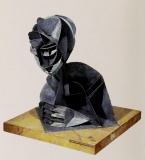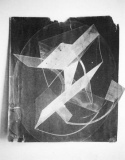Difference between revisions of "Naum Gabo"
| Line 6: | Line 6: | ||
|death_date = {{Death date and age|1977|8|23|1890|8|5|mf=y}} | |death_date = {{Death date and age|1977|8|23|1890|8|5|mf=y}} | ||
|death_place = Waterbury, Connecticut, United States | |death_place = Waterbury, Connecticut, United States | ||
| − | |collections = [http://www.berlinischegalerie.de/en/collection/collection-online/naum-gabo-online/ Berlin], [[Tate::{{Tate|1137}}|Tate]], [http://www.kettlesyard.co.uk/collection-artist/naum-gabo/ Cambridge], [[Guggenheim::{{Guggenheim|1259}}|Guggenheim]], [[MoMA::{{MoMA|2043}}|MoMA]], [http://www.dma.org/collection/search?artist_creator_exact=naum%20gabo DMA], [http://www.nationalgalleries.org/collection/artists-a-z/g/artist/naum-gabo NGS] | + | |collections = [http://www.berlinischegalerie.de/en/collection/collection-online/naum-gabo-online/ Berlin], [[Tate::{{Tate|1137}}|Tate]], [http://www.kettlesyard.co.uk/collection-artist/naum-gabo/ Cambridge], [http://artgallery.yale.edu/overall-search/gabo Yale], [[Guggenheim::{{Guggenheim|1259}}|Guggenheim]], [[MoMA::{{MoMA|2043}}|MoMA]], [http://www.dma.org/collection/search?artist_creator_exact=naum%20gabo DMA], [http://www.nationalgalleries.org/collection/artists-a-z/g/artist/naum-gabo NGS] |
}} | }} | ||
'''Naum Gabo''' (born Naum Neemia Pevsner; נחום נחמיה פבזנר) was a Russian sculptor in the Constructivism movement and a pioneer of Kinetic Art. | '''Naum Gabo''' (born Naum Neemia Pevsner; נחום נחמיה פבזנר) was a Russian sculptor in the Constructivism movement and a pioneer of Kinetic Art. | ||
| Line 34: | Line 34: | ||
}}</onlyinclude> | }}</onlyinclude> | ||
| − | === | + | ===other=== |
<gallery> | <gallery> | ||
Gabo_Naum_1917-20c_Head_of_a_Woman.jpg|''Head of a Woman'', c1917-20 (after a work of 1916). Celluloid and metal, 62.2 x 48.9 x 35.4 cm. [http://www.moma.org/collection/works/81440?locale=en MoMA]. | Gabo_Naum_1917-20c_Head_of_a_Woman.jpg|''Head of a Woman'', c1917-20 (after a work of 1916). Celluloid and metal, 62.2 x 48.9 x 35.4 cm. [http://www.moma.org/collection/works/81440?locale=en MoMA]. | ||
Gabo_Naum_1917_1981_Model_for_Constructed_Torso.jpg|model for ''Constructed Torso'' 1917, reassembled 1981. Cardboard, 39.5 x 29 x 16 cm. [http://www.tate.org.uk/art/artworks/gabo-model-for-constructed-torso-t06972 Tate]. | Gabo_Naum_1917_1981_Model_for_Constructed_Torso.jpg|model for ''Constructed Torso'' 1917, reassembled 1981. Cardboard, 39.5 x 29 x 16 cm. [http://www.tate.org.uk/art/artworks/gabo-model-for-constructed-torso-t06972 Tate]. | ||
Gabo_Naum_1919-20_1985_Kinetic_Construction_Standing_Wave.jpg|''Kinetic Construction (Standing Wave)'', 1919-20, replica 1985. Metal, wood and electric motor. 61.6 x 24.1 x 19 cm. [http://www.tate.org.uk/art/artworks/gabo-kinetic-construction-standing-wave-t00827 Tate]. | Gabo_Naum_1919-20_1985_Kinetic_Construction_Standing_Wave.jpg|''Kinetic Construction (Standing Wave)'', 1919-20, replica 1985. Metal, wood and electric motor. 61.6 x 24.1 x 19 cm. [http://www.tate.org.uk/art/artworks/gabo-kinetic-construction-standing-wave-t00827 Tate]. | ||
| + | Gabo_Naum_1921-22_Tower.jpg|''Tower'', 1921-22. Cellulose nitrate, 13 x 7.7 x 6.1 cm. [http://artgallery.yale.edu/collections/objects/50127 Yale]. | ||
Gabo_Naum_1920-21_model_for_Column.jpg|model for ''Column'', 1920-21. Cellulose nitrate, 14.3 x 9.5 x 9.5 cm. [http://www.tate.org.uk/art/artworks/gabo-model-for-column-t02167 Tate], [http://www.guggenheim.org/new-york/collections/collection-online/artists/1259 Guggenheim] (reconstructed 1937). | Gabo_Naum_1920-21_model_for_Column.jpg|model for ''Column'', 1920-21. Cellulose nitrate, 14.3 x 9.5 x 9.5 cm. [http://www.tate.org.uk/art/artworks/gabo-model-for-column-t02167 Tate], [http://www.guggenheim.org/new-york/collections/collection-online/artists/1259 Guggenheim] (reconstructed 1937). | ||
Gabo_Naum_c1921-22_Construction_en_Creux.jpg|''Construction en Creux'', c1921-22. Plastic and wood. Reproduced in the catalogue of the ''Erste Russische Kunstausstellung'', Berlin, 1922, under title ''Model for a Spatial Construction C (Model for a Plastic Glass)''. | Gabo_Naum_c1921-22_Construction_en_Creux.jpg|''Construction en Creux'', c1921-22. Plastic and wood. Reproduced in the catalogue of the ''Erste Russische Kunstausstellung'', Berlin, 1922, under title ''Model for a Spatial Construction C (Model for a Plastic Glass)''. | ||
Revision as of 12:02, 7 August 2015
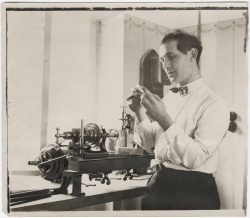 | |
| Born |
August 5, 1890 Bryansk, Russian Empire |
|---|---|
| Died |
August 23, 1977 (aged 87) Waterbury, Connecticut, United States |
| Collections | Berlin, Tate, Cambridge, Yale, Guggenheim, MoMA, DMA, NGS |
Naum Gabo (born Naum Neemia Pevsner; נחום נחמיה פבזנר) was a Russian sculptor in the Constructivism movement and a pioneer of Kinetic Art.
Contents
Biography
Born Naum Neemia Pevsner in 1890. Grew up in a Jewish family of six children in the provincial Russian town of Bryansk, where his father owned a factory. His older brother was fellow Constructivist artist Antoine Pevsner. Gabo was a fluent speaker and writer of German, French, and English in addition to his native Russian. His command of several languages contributed greatly to his mobility during his career.
After school in Kursk, Gabo entered Munich University in 1910, first studying medicine, then the natural sciences, and attended art history lectures by Heinrich Wölfflin; gained knowledge of the ideas of Einstein and his fellow innovators of scientific theory, as well as Henri Bergson. 1912 transferred to an engineering school in Munich where he discovered abstract art by reading Kandinsky's 'Concerning the Spiritual in Art'; 1913-14 joined his brother Antoine (who by then was an established painter) in Paris. Gabo's engineering training was key to the development of his sculptural work that often used machined elements. During this time he won acclamations by many critics and awards like the Logan Medal of the arts.
1914 moved first to Copenhagen then Oslo with his older brother Alexei; 1915 made his first constructions under the name Naum Gabo (changed his name to avoid confusion with Antoine); figurative objects in cardboard or wood such as the Head No.2 which was formal experiment in depicting the volume of a figure without carrying its mass. 1917 moved back to Russia to become involved in politics and art, spending five years in Moscow with Antoine.
Contributed to the Agit-prop open air exhibitions and taught at VKhUTEMAS the Higher Art and Technical Workshop, with Tatlin, Kandinsky and Rodchenko. During this period the reliefs and construction became more geometric and Gabo began to experiment with kinetic sculpture though the majority of the work was lost or destroyed. Gabo's designs had become increasingly monumental but there was little opportunity to apply them commenting "It was the height of civil war, hunger and disorder in Russia. To find any part of machinery [..] was next to impossible". August 1920 wrote and issued jointly with Antoine a Realist Manifesto proclaiming the tenets of pure Constructivism - the first time that the term was used; in it they criticised Cubism and Futurism as not becoming fully abstract arts, stated that the spiritual experience was the root of artistic production, and that art needed to exist actively in four dimensions including time; staged an exhibition on a bandstand on Tverskoy Boulevard in Moscow and posted 5000 copies of the manifesto on hoardings around the city.
In Germany Gabo came into contact with the artists of the de Stijl; 1928 taught at the Bauhaus. During this period he realised a design for a fountain in Dresden (since destroyed). 1924 joint exhibition with Antoine at the Galerie Percier, Paris. 1926 with Antoine designed the set and costumes for Diaghilev's ballet La Chatte that toured in Paris and London. To escape the rise of the Nazis in Germany the pair stayed in Paris in 1932-5 as members of the Abstraction-Creation group with Mondrian.
Gabo visited London in 1935, and settled in 1936, where he found a 'spirit of optimism and sympathy for his position as an abstract artist'. At the outbreak of WWII he followed his friends Barbara Hepworth and Ben Nicholson to St Ives in Cornwall, where he stayed initially with the art critic Adrian Stokes. Whilst in Cornwall he continued to work, albeit on a smaller scale. His influence was important to the development of modernism within St Ives, and it can be seen most conspicuously in the paintings and constructions of John Wells and Peter Lanyon, both of whom developed a softer more pastoral form of Constructivism. In 1946 Gabo and his wife and daughter emigrated to the United States, where they resided first in Woodbury, and later in Middlebury, Connecticut. Died 1977 in Waterbury, Connecticut.
Works
Constructed Head
Head No. 2, 1923-24, based on an original design of 1916. Ivory rhodoid (celluloid), 43.2 x 31.1 x 31.1 cm. DMA.
Head No. 2, 1916, enlarged version 1964. Steel. 175.3 x 134 x 122.6 cm. Tate.
other
Head of a Woman, c1917-20 (after a work of 1916). Celluloid and metal, 62.2 x 48.9 x 35.4 cm. MoMA.
model for Constructed Torso 1917, reassembled 1981. Cardboard, 39.5 x 29 x 16 cm. Tate.
Kinetic Construction (Standing Wave), 1919-20, replica 1985. Metal, wood and electric motor. 61.6 x 24.1 x 19 cm. Tate.
Tower, 1921-22. Cellulose nitrate, 13 x 7.7 x 6.1 cm. Yale.
model for Column, 1920-21. Cellulose nitrate, 14.3 x 9.5 x 9.5 cm. Tate, Guggenheim (reconstructed 1937).

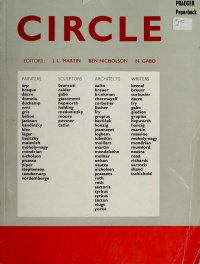
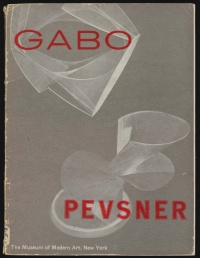

Publications
- with Nathan Pevsner (Нотон Певзнер), Realisticheskii manifest [Реалистический манифест], Moscow: Second State Printing House, 5 Aug 1920, 1 sheet (58.8x73.6 cm — edition of 5000). Issued as a poster to accompany the artists' joint open-air exhibition on Tverskoie Boulevard. Points out the limitations of cubism and futurism. 1967 recording of Gabo reading the manifesto. Commentary: Khan-Magomedov (1996). (Russian)
- "The Realistic Manifesto", trans. Naum Gabo, in Gabo: Constructions, Sculpture, Paintings, Drawings, Engravings, London: Lund Humphries, 1957, pp 151-152; repr. in The Tradition of Constructivism, ed. Stephen Bann, New York: Viking Press, 1974, pp 5-11; repr. in Russian Art of the Avant-Garde: Theory and Criticism, 1902-1934, ed. John E. Bowlt, New York: Viking Press, 1976, pp 208-214; repr. in Art in Theory, 1900-1990: An Anthology of Changing Ideas, eds. Charles Harrison and Paul Wood, Blackwell, 1992, pp 297-299. (English)
- trans. Camilla Gray, The Structurist 8, Saskatoon, 1968, pp 43-47. (English)
- "Das Realistische Manifest", in Naum Gabo: Sechzig Jahre Konstruktivismus, eds. Steven A. Nash and Jörn Merkert, Munich: Prestel, 1986, pp 203-204. (German)
- "Manifiesto realista", trans. Julio Rodriguez Puertolas, in Teorías del arte contemporáneo, ed. Herschel B. Chipp, Madrid: Akal, 1995, pp 350-355. (Spanish)
- editor, with J.L. Martin and Ben Nicholson, Circle: International Survey of Constructive Art, London, 1937; repr., New York: Praeger, 1971, viii+291 pp.
- with Katherine S. Dreier and James Johnson Sweeney, Three Lectures on Modern Art, The Philosophical Library, 1949.
- Gabo: Constructions, Sculpture, Paintings, Drawings, Engravings, intro. Herbert Read and Leslie Martin, London: Lund Humphries, 1957, 193 pp.
- Of Divers Arts, New York: Pantheon Books, 1962, xviii+205 pp. A.W. Mellon lectures in the fine arts, 8.
- Gabo on Gabo: Texts and Interviews, eds. & trans. Martin Hammer and Christina Lodder, East Sussex: Artists Bookworks, 2002, xiii+295 pp.
Catalogues
- Naum Gabo–Antoine Pevsner, New York: Museum of Modern Art, 1948.
- Naum Gabo: The Constructive Process, ed. Teresa Newman, Tate Gallery, London, 1976, 63 pp. Catalogue of an exhibition held at the Tate Gallery, 3 Nov-12 Dec 1976.
- Naum Gabo: Sixty Years of Constructivism, eds. Steven A. Nash and Jörn Merkert, Munich: Prestel, 1985, 272 pp. Published on the occasion of the exhibition held at the Dallas Museum of Art, 29 Sep-17 Nov 1985 and various other locations; includes the Catalogue Raisonné and a complete Chronology.
- Naum Gabo: Sechzig Jahre Konstruktivizmus, Munich: Prestel Verlag, 1986.
- Naum Gabo Monoprints, ed. Graham Williams, Ashford: Florin Press for Kettle's Yard, Cambridge & The Talbot Rice Gallery, Edinburgh, 1987, 71 pp.
- Naum Gabo: The Constructive Idea: Sculpture, Drawings, Paintings, Monoprints, London: South Bank Board, 1987, 64 pp. Exhibition held at Museum of Modern Art, Oxford, England, 13 Dec 1987-7 Feb 1988, and elsewhere.
- Naum Gabo, ein russischer Konstruktivist in Berlin 1922-1932: Skulpturen, Zeichnungen und Architekturentwürfe, Dokumente und Archive aus der Sammlung der Berlinischen Galerie, ed. Jörn Merkert, Berlin: Berlinische Galerie, 1989, 158 pp. (German)
- Naum Gabo, 1890-1977, Annely Juda Fine Art, London, 1990.
- Naum Gabo, Annely Juda Fine Art, London, 1999.
- Naum Gabo and Colour, Annely Juda Fine Art, London, 2004.
- Naum Gabo Monoprints, Alan Cristea Gallery, London, 2006.
Literature
- Books
- Andrew Forge, An Appreciation of Naum Gabo, foreword Norman Reid, Biddenden/Kent: Florin Press, 1985, 47 pp.
- Martin Hammer, Christina Lodder, Constructing Modernity, the Art and Career of Naum Gabo, Yale University Press, 2000, 528 pp. TOC.
- Articles
- Selim Khan-Magomedov, "Реалистический манифест" и пространственные конструкции Н. Габо и Н. Певзнера", in Архитектура советского авангарда. (in Russian)
- Christina Lodder, "Naum Gabo and the Quandaries of the Replica", Tate Papers, 2007.
- Christina Lodder, "Naum Gabo as a Soviet Émigré in Berlin", Tate Papers, 2010.
- Talks
- Christina Lodder, "Naum Gabo: Discovering the Archive", 2009.

